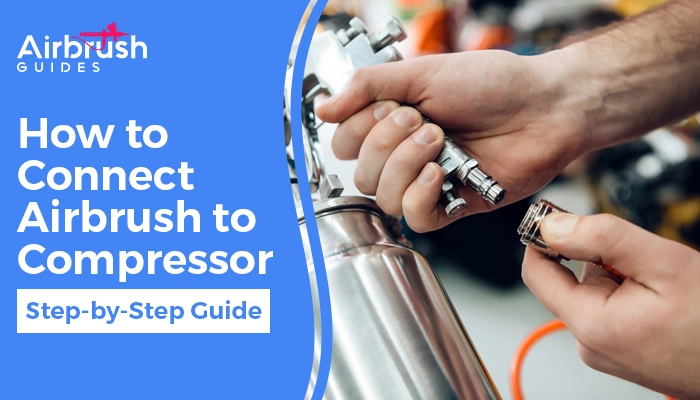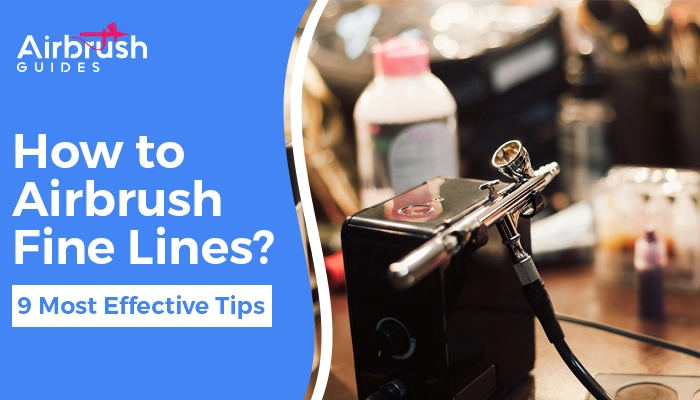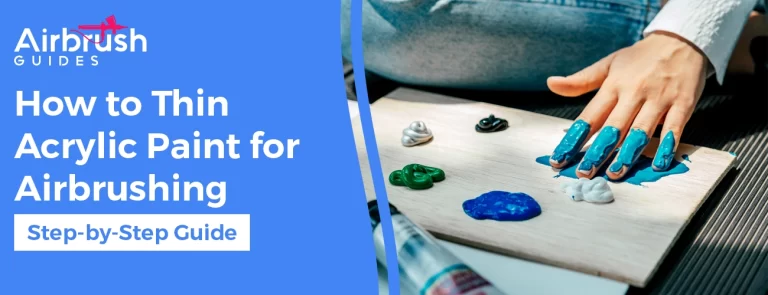How To Make Airbrush Paint? A Step-By-Step Guide
You won’t experience the agony and anguish that come with permanent tattoos with this form of art. On the other hand, you might want to use airbrush paint to spray on cakes or on any utensils, but you may not know how to make airbrush paint. And for that, we have all the info for you.
Body paints and tattoos have been quite popular in recent years among both young and old individuals. Each person’s own preferences are reflected in the tattoos’ style and layout. There are several sorts of airbrushes available that are made to produce different effects.
For instance, a single-action airbrush is designed to spray both paint and air simultaneously, but a double-action airbrush allows the user to control the flow of both paint and air as needed.
Airbrush painting is created by using sprayer equipment to apply the paint. When purchasing paints, the viscosity and safety of the additives should be considered as utmost priority. The paint of your choosing and an airbrush (a spraying tool) is required. There are kits for airbrush tattoos that include stencils, a sprayer, and ink.
How To Make Airbrush Paint For Cakes – Guide
The cake airbrush set is made in a very straightforward manner. The airbrush gun and compressor are first attached to the provided hose. Connect the power source to the compressor. Airbrush settings for cakes frequently include a three-stage compressor adjustment that makes working with them simple.
Your intended creation will determine how high the pressure has to be set. After setting up your work surface, add the selected paint to the airbrush gun’s paint container.
Don’t add too much paint to the gaps. Typically, two or three drops are plenty. If you overfill the container with paint, you must dump the extra paint out. Because of this, it is preferable to apply a little paint and refill it as needed.
For your work on cakes, you should unquestionably utilize a rotating cake plate. It is highly worthwhile to create one if you don’t already have one because it will make your work a lot simpler. By airbrushing the cake or coating it with fondant, you may save a lot of time and effort.
The extraction system’s impact is comparable to that of this. Your working space will stay somewhat clean thanks to the side walls and the extractor hood. There are several applications for an airbrush pistol.
It may be used to airbrush cake decorations in addition to spraying tattoos or automobile components. You can essentially create any type of artwork on a cake with a cake airbrushing machine:
- 3D effects
- Clear images
- Lovely color gradients and shades
- Beautiful decorations
- Various shapes and patterns
How to Thin Airbrush Paint
Before using paint for airbrushing, it often has to be diluted. Lack of adequate paint thinning before using an airbrush can cause clogging and make it difficult to spray paint thinly and evenly. You may use any kind of paint with an airbrush by following the instructions in the section that follows. The majority of the time, airbrush paint is water-based, making it simple to thin with water.
That problem is typically not present in higher-quality airbrush paints. However, certain paints that are not water-based can be applied using an airbrush. We will go through all the most popular paints, how to thin them when it makes sense to use airbrush thinner, and common substitutes for airbrush thinners in the parts that follow.
Acrylic Paint Thinned With Water
Many seasoned painters, as well as aspiring ones, use acrylic paint. It is inexpensive, simple to use, and sprayable with an airbrush but only after appropriately thinning the paint. Overall, acrylic paint may be thinned with water for airbrushing, but the paint must have a high pigment density to prevent becoming less opaque after thinning. Water may typically be used to thin high-quality acrylic paints without any problems.
The box of the majority of higher-quality acrylic paints includes information regarding the pigment density. It might be challenging to determine whether and how much cheaper paints can be diluted with water since they lack information on the pigments.
For airbrushing, a medium to high density works well. The only thing you can do if you don’t know anything about the paint is to try how well it thins with water.
In order to get a lovely thin consistency, simply add water to the paint. After that, apply some of the diluted paint with a brush on a piece of paper.
Thinning Airbrush Paint With Airbrush Cleaner
It is only logical that artists who are unfamiliar with airbrushing look for alternatives to the more premium airbrush thinners, as we all know that airbrush materials can be rather pricey. Generally speaking, airbrush cleaners shouldn’t be used as thinner because that might result in paint that doesn’t adhere well.
It can result in an uneven surface with the paint losing its ability to adhere correctly if airbrush cleaning is used. It is advised to dilute oil-based paints using Mineral Spirit rather than water.
Therefore, we advise against thinning any airbrush paint and just using airbrush cleaning to clean the airbrush or surfaces from paint. The effects will often be far worse than properly diluting the paint with either water or mineral spirits, even if it may work for some colors.
If you are unsure of the type of paint you have, you may always use airbrush thinners from the same manufacturer as the paint.
Thinning Paints With Regular Paint Thinner
A regular paint thinner can be used for airbrushing in general, but only if it is not an aggressive solvent. Parts of the airbrush might be damaged if the thinner is too forceful. Almost all water-based paint thinners are safe to use; however, some oil-based paint thinners can be excessively harsh.
The thinner’s package often includes information on how aggressive it is against certain materials as well as what sorts of materials it may come into contact with without damage.
Spray-On Body Paint
This type of painting is regarded as transitory body art since it often lasts from a few days to around a week. The paints are often water-based and are readily wiped with body oils.
The non-toxic components are selected so that the paint dries in a matter of seconds. There are ready-to-use airbrush body paints on the market; you can get them from any drugstore that sells cosmetics. You can make the paint yourself if the color you want is not readily available.
- You will need mixing bowls and storage containers, glycerin, cornstarch, baking soda, water, and vinegar to do that.
- The following is the list of components needed to make half a gallon of paint: Two cups of vinegar, two cups of cornstarch, one cup of baking soda, and half a cup of water. Depending on the color range you want to achieve, different amounts of food coloring are used.
- Baking soda and vinegar should be combined in a mixing basin. Stir thoroughly, then let the mixture rest for a while.
- Add everything else except the water to the recipe. Mix them thoroughly to ensure that the food coloring is evenly distributed.
- To get a consistently thick paint, slowly add water drop by drop while swirling continually. When the required paint viscosity is reached, stop adding water.
- For producing paints in other hues, use identical techniques. The various paints can be kept in separate containers with airtight covers.
A simpler option to the preceding technique is to create the desired hue by properly combining two or more pre-made airbrush body paints. The decision of the artist’s design is up to the person. For special events or certain days, some individuals enjoy this type of painting.
In these situations, the tattoo design’s theme typically corresponds with the event. You may draw lovely designs, scary scorpions, or stunning butterflies.
You might also create a portrait of the person you admire the most. One benefit of this art is that stencils allow even a novice to create the designs.
What Qualities Should Ideal Sprayable Liquids And Airbrush-Ready Paints Have?
The following qualities must be observed in sprayable liquids and airbrush paints.
- They have finely powdered pigments and are strained to be free of lumps that may clog an airbrush.
- Skim milk or another thinner should be used to thin paints, and they should be well-blended and clump-free.
- They resemble skim milk in terms of consistency or are thinner.
- Consider that the thickness of the paint may need to be altered if you are having problems spraying a certain brand or color; an airbrush malfunction is probably not the cause.
- They have additives that generate “flow” through an airbrush, making cleanup quicker and blockages less likely.
- For the best spraying results, certain ready-to-use airbrush colors will still require thinning.
Tips for Using Airbrush Paint
- To produce stippled or spattered effects, lower the airbrush’s air pressure.
- Color dilution enhances transparency.
- Your air pressure may be reduced when the paint is thinned, allowing you to hold the airbrush closer to the work area and add more detail. Colors will seem brighter and more even when tones are built up gradually during airbrushing.
- For a color to be persistent when applied to fabric, it must penetrate the fabric and be visible as a ghost image on the reverse side. Before washing or dry cleaning, let the item for three days to cure.
- As you apply more airbrush layers, the absorbency will decrease.
- Whenever possible, operate in a location with excellent airflow.
How to Thin and What Sort of Paint to Use for Airbrushing
Overall, a wide variety of paints, including commercial airbrush paint, enamel paint, acrylic paint, and latex paint, may be utilized with an airbrush. Acrylic paint or industrial airbrush paint work best for novices. Water may be used to readily thin acrylic paints. Regular water or an airbrush thinner is typically used to dilute airbrush paints, depending on whether they are water-based or not.
Acrylic Color
Overall, acrylic paint is suitable for airbrushing. However, the paint must be diluted with water to get the desired consistency. The best acrylic paints for airbrushing are those that have high quality or flow rates. Unless these acrylic paints are of good quality, you shouldn’t use the regular acrylic paint that you still have at home. That’s because cheap acrylic paint, even when properly diluted, has a tendency to clog your airbrush.
Enamel Paint
Enamel paints may provide a really fine finish, but they are difficult to thin correctly, shouldn’t be sprayed without a mask, and are difficult to remove from an airbrush after use. Finally, enamel paint may also be used for airbrushing.
Since it can be difficult to thin enamel paint adequately for airbrushing and since oil-based paints like enamel paint are difficult to remove from the airbrush, we personally do not advise using them if you are just starting out with airbrushing.
Enamel paint must first be thinned with White Spirit and Mineral Spirit before it can be used for airbrushing. Even while cleansing the airbrush after spraying enamel paint might take some time, it provides a highly saturated and even surface after it has dried.
Conclusion
This was a discussion about how to make airbrush paint in which the guide explained making airbrush paint in an easy way. You can learn how to make airbrush paint and things ready and mix them accordingly to get the desired results.
FAQ’s
Can you create edible airbrush paint on your own?
Combine food coloring gel and an alcohol base, such as vodka to create airbrush food coloring. To prevent clumps, thoroughly blend the gel with the alcohol base. To guarantee that the food coloring solution flows out of the airbrush nozzle, fully dissolve the gel. This approach is really simple and reasonably priced.






